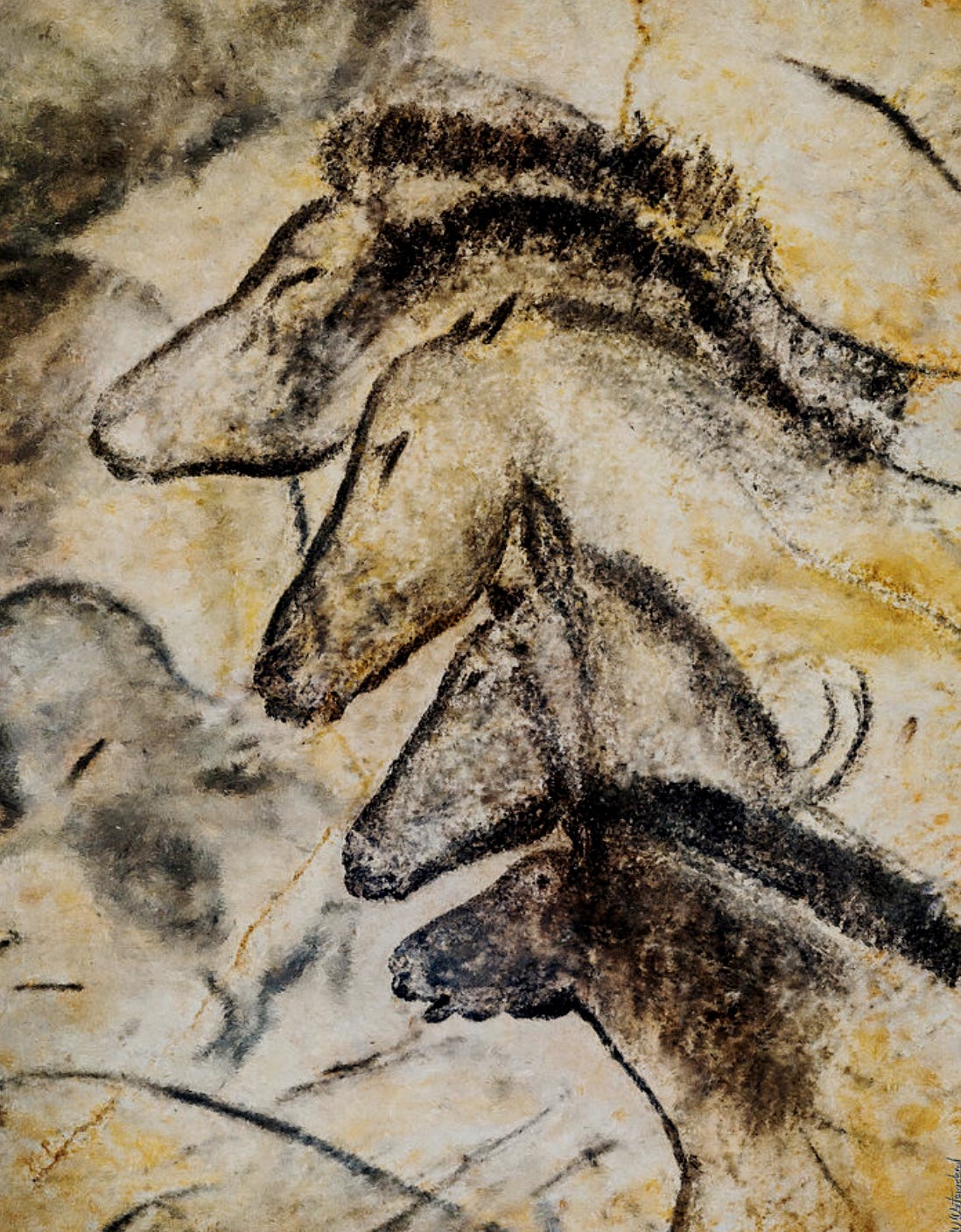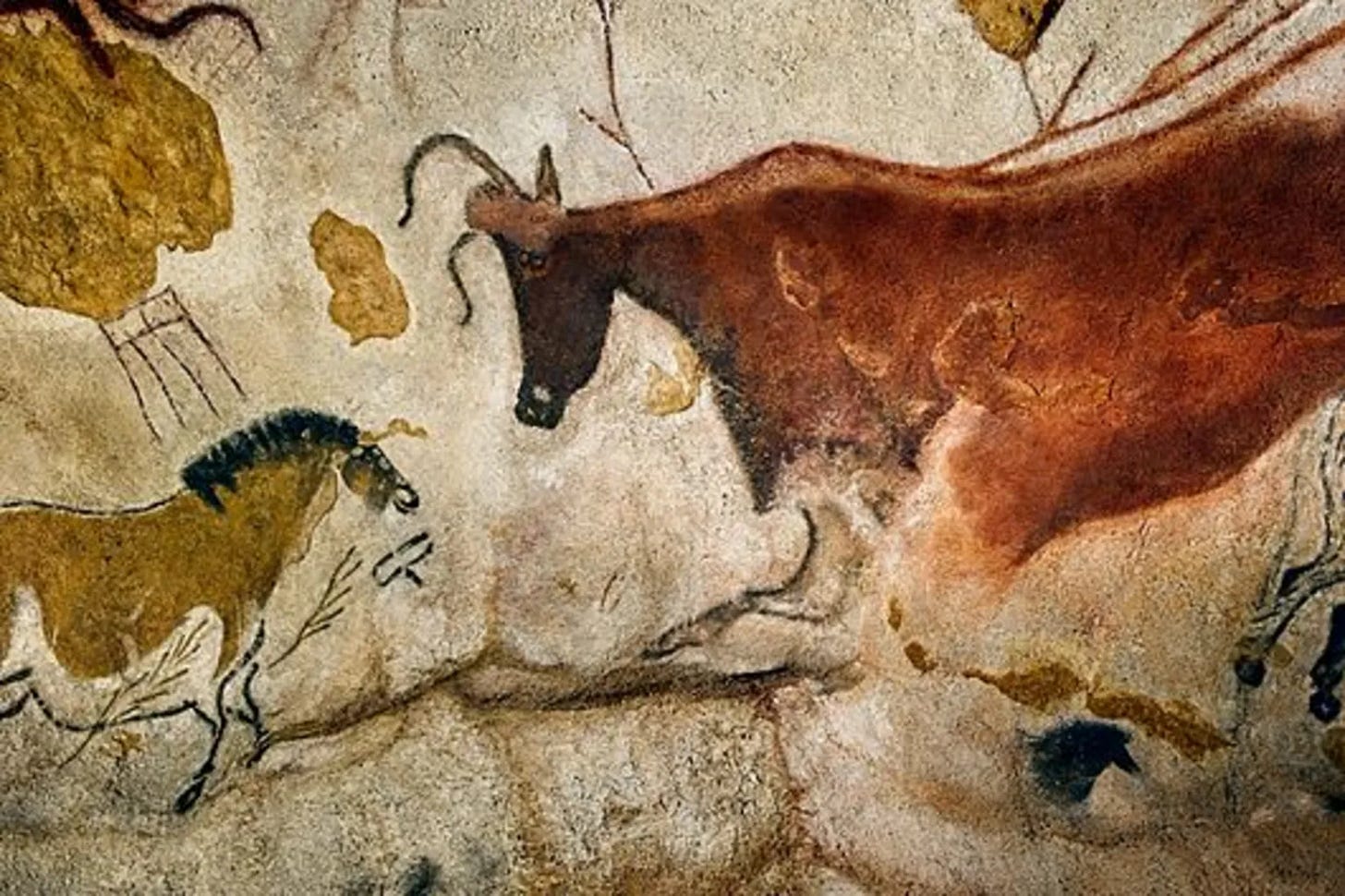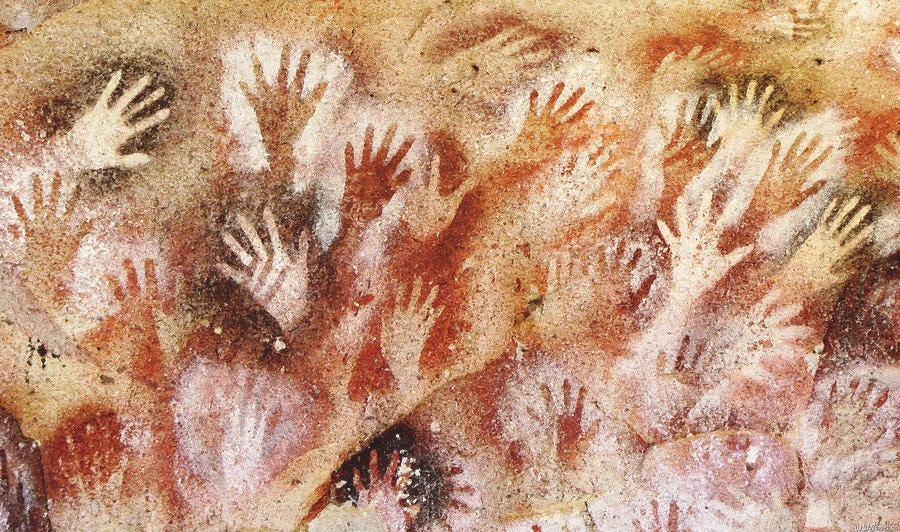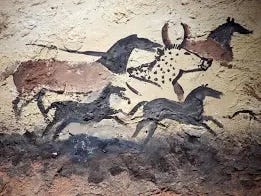Ode to CAVE ART
And How We Became Human
A few years ago, I got really sick after the New Year --- a viral coughing thing that hung on for weeks and weeks. My doc was convinced by the telehealth where I could hardly speak and so called in four different scripts. But nothing helped. It would be more than two months before my bloodwork returned to normal.
In the midst of it, everything in the apartment stopped on a dime. Half-done things were scattered all around --- bags and little piles lay on surfaces everywhere, frozen in place like Pompei. But something crazy happened then and it pierced those long, languid days like an ancient spear.
I was sitting in our upholstered chair in my sweats and the t-shirt I’d slept in with a cup of coffee in my hand just staring into space when my eyes happened to run across something half-wrapped at the top of a bag by the back door. What is that? I thought. Is that an ornament? I finally walked across the foyer and pulled it out so I could see.
Oh! The horses! For Christmas I’d been given by my mother-in-law, Barbara, this little piece of art, maybe six by four inches, a pen and ink drawing on a lovely off-white, rough-hewn surface. Mounted on cork, it was lighter than it looked, and I turned it over a few times in my hands as I made my way back to the chair.
I see then that the drawing is not of horses exactly; the drawing is of two quietly magnificent young impalas or gazelles, walking in what looks like a procession, in a single flat plane. And it was only then that I actually identified its genre ----- cave art.
I knew nothing about cave art. In fact, I’ve always lamented the two gorgeous art history survey classes I never took in college. Still staring at it, I walked over to the desktop and the googling commenced: “cave art”, “early human art”, “ancient art”, “first human drawings” and over and over as I hopscotched past all the commentaries to images, images, more images.
I didn’t care so much about the commentaries because, frankly, I knew the archeologists, scientists and historians would not be able to answer the most pressing question I had --- Why? What prompted these early humans to draw and paint? How was it that these Paleolithic people could go from a brute, animal-like existence (It was the Ice Age!) to this incredibly elevated pursuit of art?
I was right --- experts still can’t really answer this. The paintings pre-date written language so we can only guess about the internal promptings of these, the first human artists. It seems what they’ve uncovered about the paintings has only drawn the phenomena into deeper mystery.
This is what we know: the first paintings appear quite spontaneously. There was no real onramp to them ---- like sketches or studies. They go pretty much full-bore, from not painting at all to suddenly covering entire cave walls with grand, gorgeous, magnificent paintings.
The other incredible thing is that this happens in various locations across four different continents separated by vast distances. It suggests a very wild synchronicity – not an inspiration from a single source that’s then diffused or carried but instead a somewhat miraculous shared cognitive leap, impossible to source.
Consider with me the size and scope of this leap: without language to describe to themselves what they were doing (even in their own minds), without art school or museums, without ever having even seen a piece of actual art or even art supplies for that matter, from someplace deep inside themselves and deep inside those caves, sprang a desire so fierce that it surely competed with matters of their own survival. And it won.
As far as I’m concerned, Jobs, Gates, Musk and Franklin together have nothing on these cave people. To me, it’s for humans like the mastery of fire.
The word person comes from an old French word per-sonare, which literally means sounding through.1 This is exactly what was happening here --- they were miraculously sounding through, from brute survival ---- the cold, the earth, the dust, the wind, their thirst, their hunger --- to something utterly new and different, the ability to think abstractly, to wonder, not just in search of meaning but suddenly knowing there was such a thing.
They come to understand that they are in possession of something new and wholly precious. But it did not function a wit like all the other elements in their world – the things they consumed, like food or water, the things they feared, like the animals they hunted or that hunted them. Nor was it something they would have to master or mitigate, like weather or wind. It wasn’t transactional in any sense. What they had that was new was something to say about all those other things. What they had, in short, was a story. And as they told it, they quite literally became human.
Daniel Nayeri said in his memoir Everything Sad is Untrue : every story is the sound of the storyteller begging to stay alive. What Nayeri meant by it exactly I’m not sure but he’s clearly rounding on a fierce connection between narrative and life, story and the will to live.
This all washed over me as absolute revelation that day. I couldn’t believe my eyes. I was filled with curiosity and compassion for my new friends, my fellow sojourners. I couldn’t wait for someone to get home so I could start showing them the images. I forgot all about my CF Seasonal Support drops, my zinc lozenges and my walk around the block before I went down for a nap. I forgot everything. I had entered the caves, and their strangely beautiful, two-dimensional world. I was, like them, suddenly seeing it: life and the mystery of myself.
Months later it hits me: I realize that my new short, hairy friends – well, they were the first. They were the first humans to come to the nuisance! They’re the honorary mamas and papas of my newsletter. They were the first to know ---- that there was something about this life that’s both intractably impossible and persistently beautiful. They were the first to know and send up a flare.
I found the loveliest response to these mysterious cave people from Sister Wendy in a short video I found on YouTube called charmingly The Mists of Time. I’m wild-guessing you’re familiar with the sweet, older nun who became semi-famous in the nineties for a BBC television series about the history of art? They’re worth every minute. (I’ll link to a few.)
First of all, her vibe is pitch-perfect. She sustains this awe-inspired, hushed tone throughout the video that I so think the artists and the paintings deserve. The video was shot at the Lascaux caves in France, and she moves through its cavernous tunnels like an elder Joan of Arc, reminding us all the while how cold it was back then and how dark, her habit swooshing dramatically behind her as she turns.
She definitively sets aside the work of earlier historians who’d suggested the paintings might be evidence of some kind of ritual around hunting. It turns out the only animal they hunted for food in France at that time were reindeer and there were literally no depictions of those. She insists the pieces are not a tit for tat. It was profligate. It was art.
She makes particular mention of a painting of a Mongolian horse --- her favorite --- noting the “inspired black calligraphy of the legs”, “the great sway of its belly”. It doesn’t really look like that, Sister Wendy turns to the camera to say, something playful and conspiratorial playing across her face. The cave artists actually enhanced the look of the horse, she explains; they painted what they wished it to be.
It’s, dare I say it, an impressionistic horse. Her body is leaning forward here, her palms outstretched and then returning to her, clasping at her heart.
But before she wraps on the cave people to move to the coming dark age (the next 15,000 years when art completely and mysteriously disappears again), she returns to the question that keeps us guessing -- Why. Why did they do it? Why did they paint? What were they thinking? And she makes an incredibly poignant guess:
How humankind must have yearned to be strong, beautiful,
free and innocent.
All the things they were not.
And we are not.
Oh, Sister Wendy. Yes! You’re a poet.
Inside this great yearning, two new but opposing ideas grew up inside them – a sudden recognition of the value of themselves and of life itself and then this other thing, a shadow thing, a knowing that they could not possibly live up to it. They would fall short.
And they knew another thing too: the only logical response was not to try to solve it.
But to tell it.







Lovely, thank you!